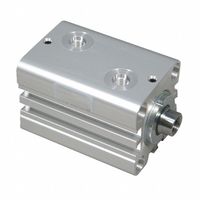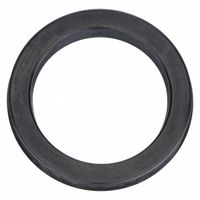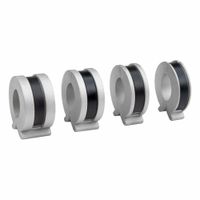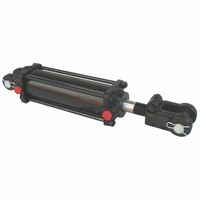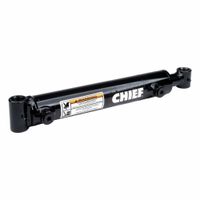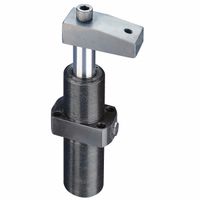Call +(254) 703 030 000 / 751 483 999 / 721 704 777
- Home
- Hydraulics
- Hydraulic Cylinders Seals
.....Read More
Frequently Asked Questions
What are the main components of a hydraulic cylinder?
A hydraulic cylinder, a mechanical actuator, is composed of several key components that work in unison to convert hydraulic energy into linear mechanical force and motion. The primary components include: * **Cylinder Barrel:** This is the main body of the cylinder, a precision-honed tube that houses the piston and rod. It contains the hydraulic fluid and withstands the internal pressure.
* **Piston:** A cylindrical component that fits snugly inside the cylinder barrel. It divides the barrel into two chambers and is pushed by hydraulic fluid pressure.
* **Piston Rod:** Attached to the piston, this rod extends out of the cylinder barrel. It transmits the force generated by the piston to the external load.
* **Gland (Head End Cap):** This component is located at the end of the cylinder where the piston rod extends. It seals the rod and often contains the rod seal and wiper.
* **Cap (Blind End Cap):** This is the opposite end of the cylinder barrel from the gland. It seals the blind end chamber and often contains the hydraulic ports for fluid entry and exit.
* **Seals:** Various types of seals (e.g., piston seals, rod seals, static seals) are crucial for preventing internal and external leakage of hydraulic fluid, ensuring efficient operation.
* **Ports:** These are threaded openings in the cylinder through which hydraulic fluid enters and exits, directing the flow to either side of the piston.
* **Mounting Options:** Cylinders are designed with various mounting configurations (e.g., clevis mounts, flange mounts, trunnion mounts) to facilitate their integration into different machinery and applications.These components collectively enable the hydraulic cylinder to perform its function of generating powerful linear motion in a wide range of industrial and mobile equipment.
How do hydraulic seals work in a cylinder?
Please tell me what topic you would like me to elaborate on.
What are the common types of hydraulic cylinders?
Hydraulic cylinders are mechanical actuators that convert hydraulic energy into linear mechanical force and motion. They are widely used in various industries for tasks requiring significant force, such as construction, manufacturing, and material handling. The common types of hydraulic cylinders include: * Single-acting cylinders: These cylinders extend using hydraulic pressure, but retract using an external force, such as a spring or gravity. They are simpler in design and often used in applications where a controlled return is not critical.
* Double-acting cylinders: These cylinders use hydraulic pressure for both extending and retracting the rod, providing controlled movement in both directions. They are commonly found in heavy machinery and industrial equipment where precise control is required.
* Telescopic cylinders: These cylinders consist of multiple stages or sleeves that extend and retract telescopically, allowing for a longer stroke length compared to their retracted length. They are ideal for applications with limited space, such as dump trucks and cranes.
* Ram cylinders: These are single-acting cylinders where the rod diameter is nearly equal to the piston diameter, resulting in a large force output for a given pressure. They are often used in lifting applications like car lifts and presses.
* Tie-rod cylinders: These are common industrial cylinders assembled with tie rods that hold the end caps to the cylinder barrel. They are robust and easy to repair, making them suitable for heavy-duty applications.
* Welded-body cylinders: Unlike tie-rod cylinders, welded-body cylinders have their end caps welded directly to the barrel. This design offers a more compact and durable solution, often preferred in mobile equipment due to their resistance to shock and vibration.Each type of hydraulic cylinder is designed for specific applications, varying in terms of force, stroke, and operating conditions.
How do you maintain hydraulic cylinders and seals?
Maintaining hydraulic cylinders and seals is crucial for the longevity and efficiency of hydraulic systems. Regular inspection is key. Check for any visible leaks around the seals, rods, and barrel. Even minor weeping can indicate a developing issue. Look for scratches, dents, or corrosion on the cylinder rod, as these can damage seals and lead to leaks.
Fluid quality is paramount. Ensure the hydraulic fluid is clean and free of contaminants. Contaminated fluid is a major cause of seal wear and system component damage. Regularly check the fluid level and top up if necessary, using the correct type of fluid specified by the manufacturer. Implement a robust filtration system and adhere to recommended filter change intervals.
Proper seal selection and installation are also critical. Use the correct type of seals for the application and operating conditions, considering factors like pressure, temperature, and fluid compatibility. When replacing seals, ensure the cylinder components are clean and free of burrs. Use appropriate tools to avoid damaging the seals during installation.
Maintain proper system pressure and temperature. Operating hydraulic systems beyond their recommended pressure and temperature limits can accelerate seal degradation. Ensure the system is adequately cooled and that pressure relief valves are functioning correctly.
Finally, proper lubrication of the rod in dynamic applications helps reduce friction and wear on the seals. Regular, preventive maintenance schedules, including fluid analysis and component replacement based on wear, will significantly extend the life of hydraulic cylinders and seals.
What causes hydraulic cylinder failure?
Hydraulic cylinder failure can stem from various factors, often interconnected. A primary cause is contamination within the hydraulic fluid, which can introduce abrasive particles that wear down seals, cylinder walls, and piston rods, leading to leaks and reduced efficiency. Over time, this contamination can also degrade the fluid itself, diminishing its lubricating properties and increasing internal friction.
Another significant contributor is improper maintenance. Neglecting regular fluid changes, filter replacements, and seal inspections allows minor issues to escalate. Worn or damaged seals, for instance, are a common failure point, leading to external leaks, internal bypass, and loss of pressure.
Mechanical stresses also play a crucial role. Misalignment during installation can cause uneven wear on components. Excessive side loading on the piston rod can bend or score the rod, damaging seals and bearings. Additionally, operating the cylinder beyond its rated pressure or temperature limits can cause material fatigue, leading to cracks in the cylinder barrel or rod, and ultimately, catastrophic failure.
Corrosion, particularly in harsh environments, can pit and degrade the metallic surfaces of the cylinder, compromising its structural integrity and creating pathways for leaks. Lastly, incorrect component selection, such as using a cylinder that is undersized for the application's load requirements or one made from unsuitable materials, will inevitably lead to premature failure. Addressing these issues through proper design, installation, and diligent maintenance is crucial for preventing hydraulic cylinder failure.
How do you replace hydraulic seals?
Replacing hydraulic seals requires careful attention to detail to ensure proper function and prevent leaks. First, safely depressurize the hydraulic system and drain the fluid. Next, disassemble the component containing the seal, such as a cylinder or valve, taking care to note the order of parts. Carefully remove the old seal using appropriate tools, avoiding damage to the seal groove or piston rod. Clean all components thoroughly, removing any dirt, debris, or old fluid residue. Inspect the seal groove and piston rod for any scratches, nicks, or wear that could compromise the new seal. Before installing the new seal, lubricate it with clean hydraulic fluid compatible with your system. Carefully install the new seal, ensuring it is not twisted or pinched. Some seals may require special tools for installation. Reassemble the component in the reverse order of disassembly, ensuring all fasteners are tightened to the manufacturer's specifications. Finally, refill the hydraulic system with the correct fluid and bleed any air from the system according to the manufacturer's recommendations. Test the system for leaks and proper operation before returning it to service.
What are the signs of a leaking hydraulic cylinder?
The signs of a leaking hydraulic cylinder can vary depending on the severity and location of the leak, but common indicators include: * Visible fluid leaks: The most obvious sign is the presence of hydraulic fluid around the cylinder or on the equipment. This could be a steady drip, a persistent wetness, or even a spray if the leak is under pressure.
* Decreased performance: A leaking cylinder will often struggle to maintain pressure, leading to a noticeable drop in the efficiency or power of the hydraulic system. This might manifest as slow operation, an inability to lift heavy loads, or erratic movement.
* Spongy or inconsistent operation: If air enters the system due to a leak, the cylinder's movement may become "spongy" or inconsistent, lacking the smooth, precise action of a healthy system.
* Excessive heat: A leak can cause the hydraulic fluid to bypass the intended path, leading to increased friction and heat generation within the system. This can be detected by touching the cylinder or lines (with caution).
* Contamination: Leaks can allow contaminants like dirt, water, or air to enter the hydraulic system, which can further damage components and reduce the lifespan of the fluid.
* Increased fluid consumption: You may notice that the hydraulic reservoir needs to be refilled more frequently than usual if there's a leak.
* Piston rod scoring or damage: External leaks might be accompanied by visible damage to the piston rod itself, such as nicks, scratches, or wear, which can be both a cause and a symptom of a leak.Addressing a leaking hydraulic cylinder promptly is crucial to prevent further damage to the system and ensure safe operation.
How do you size a hydraulic cylinder for a specific application?
Sizing a hydraulic cylinder involves several key considerations to ensure it meets the application's requirements. First, determine the necessary force output, which depends on the load to be moved and any required safety factors. This force, combined with the available hydraulic system pressure, will dictate the cylinder's bore size. The formula for force is Pressure x Area, so rearranging to find the area (and thus the bore) is crucial.
Next, consider the stroke length, which is the distance the cylinder needs to extend or retract. This is usually determined by the application's movement requirements. The cylinder's mounting style (e.g., clevis, trunnion, flange) is also important, as it affects how the cylinder integrates into the machinery and handles the load.
Speed of operation is another factor. This influences the required flow rate of hydraulic fluid, which in turn affects pump selection and valve sizing. Account for the cylinder's internal friction and any resistance from the load. Finally, material selection for the cylinder components (barrel, rod, seals) must be appropriate for the operating environment, including temperature, pressure, and potential exposure to corrosive substances. Accurate sizing prevents premature wear, ensures efficient operation, and maximizes the cylinder's lifespan.
What materials are used for hydraulic seals?
Hydraulic seals are critical components in hydraulic systems, preventing fluid leakage and maintaining pressure. Various materials are used, each offering distinct properties suited for different operating conditions.
Nitrile rubber (NBR) is a common choice due to its excellent resistance to petroleum-based oils and good mechanical properties. It's cost-effective and performs well in a wide range of temperatures.
Polyurethane (PU) is known for its exceptional abrasion resistance, high tensile strength, and tear resistance, making it suitable for high-pressure and dynamic applications. It also offers good resistance to various oils and chemicals.
Fluorocarbon rubber (FKM), often referred to as Viton, provides superior heat and chemical resistance, making it ideal for high-temperature applications and systems using aggressive hydraulic fluids. However, it is generally more expensive than NBR or PU.
Ethylene Propylene Diene Monomer (EPDM) is used when resistance to phosphate ester-based hydraulic fluids, water, and steam is required. It's not suitable for petroleum-based fluids.
Polytetrafluoroethylene (PTFE), or Teflon, offers very low friction, excellent chemical resistance, and a wide temperature range. It's often used in combination with O-rings (as energizers) for piston and rod seals, especially in applications requiring high speeds and low friction.
Other specialized materials include silicone for extreme temperature flexibility, hydrogenated nitrile butadiene rubber (HNBR) for improved abrasion and heat resistance over NBR, and various thermoplastics like PEEK for very demanding applications. The selection of material depends on factors such as operating pressure, temperature, fluid compatibility, and dynamic or static sealing requirements.
How do you troubleshoot hydraulic cylinder problems?
Troubleshooting hydraulic cylinder problems involves identifying the root cause of issues such as leaks, slow operation, erratic movement, or complete failure. Begin by checking for external leaks around seals, fittings, and ports. If leaks are present, replace damaged seals or tighten connections.
Next, assess the hydraulic fluid itself. Low fluid levels can lead to cavitation and poor performance, so ensure the reservoir is adequately filled. Contaminated fluid, indicated by discoloration or particles, can damage components; a fluid change and filter replacement may be necessary.
Evaluate the hydraulic pump's performance. A failing pump might cause low pressure or flow, affecting cylinder operation. Listen for unusual noises and check system pressure with a gauge.
Inspect the cylinder itself. Scored or pitted cylinder rods can cause leaks and premature seal wear. Bent rods will lead to binding and erratic movement. Internal leaks, where fluid bypasses the piston seal, can be diagnosed by checking for pressure differentials across the cylinder or by observing a "drifting" cylinder even when the control valve is centered.
Finally, examine the control valve. A malfunctioning valve can prevent fluid from reaching the cylinder or can cause it to extend or retract incorrectly. Sticky spools or worn out components within the valve can lead to erratic or no movement.
Systematic troubleshooting, starting with the simplest checks and progressing to more complex diagnostics, will help pinpoint and resolve hydraulic cylinder issues efficiently.
